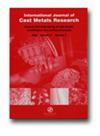用水玻璃粘结剂和铝合金熔体渗透挤压铸造法制备碳纤维预制体
IF 1.1
4区 材料科学
Q3 METALLURGY & METALLURGICAL ENGINEERING
International Journal of Cast Metals Research
Pub Date : 2022-05-02
DOI:10.1080/13640461.2022.2069913
引用次数: 0
摘要
摘要为了降低pan基碳纤维预成型件的成型成本,采用水玻璃粘结剂代替传统的硅粘结剂。采用挤压铸造的方法,在预制体中加入铝合金熔体,制备纤维增强复合材料。对复合材料的微观结构和性能进行了比较。在复合材料中,水玻璃粘结剂主要停留在纤维-铝界面附近,部分分布在基体中。合金熔体与粘结剂界面附近的反应未被识别。使用水玻璃粘结剂的复合材料的热膨胀系数、导热系数和抗压强度与使用二氧化硅粘结剂的复合材料大致相当。基于这些结果,水玻璃可以作为硅溶胶的替代粘合剂。本文章由计算机程序翻译,如有差异,请以英文原文为准。
Fabrication of carbon fibre preform with water-glass binder and infiltration of aluminium alloy melt by squeeze casting
ABSTRACT For reducing the forming cost of the PAN-based carbon fibre preforms, a water glass binder was used as a substitute for conventional silica binder. The preforms were infiltrated with an aluminium alloy melt by squeeze casting to fabricate the fibre-reinforced composites. The microstructure and properties of the composites were compared to the composites using the silica binder. In the composites, the water glass binder mainly remained in the vicinity of the fibre–aluminium interface and partially distributed in the matrix. The reaction near the interface between the alloy melt and binder was not recognised. The thermal expansion coefficient, thermal conductivity and the compressive strength of the composites using the water glass binder were approximately equivalent to those of the composite using the silica binder. Based on these results, the water glass can be used as an alternative binder to the silica sol.
求助全文
通过发布文献求助,成功后即可免费获取论文全文。
去求助
来源期刊
CiteScore
2.70
自引率
7.10%
发文量
14
审稿时长
7.5 months
期刊介绍:
The International Journal of Cast Metals Research is devoted to the dissemination of peer reviewed information on the science and engineering of cast metals, solidification and casting processes. Assured production of high integrity castings requires an integrated approach that optimises casting, mould and gating design; mould materials and binders; alloy composition and microstructure; metal melting, modification and handling; dimensional control; and finishing and post-treatment of the casting. The Journal reports advances in both the fundamental science and materials and production engineering contributing to the successful manufacture of fit for purpose castings.

 求助内容:
求助内容: 应助结果提醒方式:
应助结果提醒方式:


